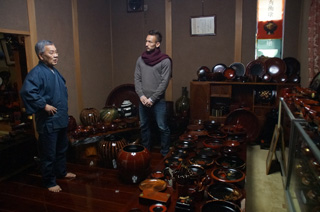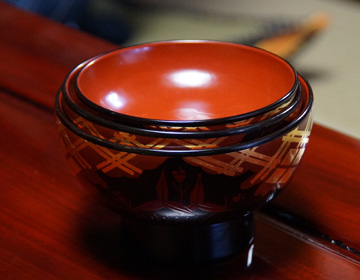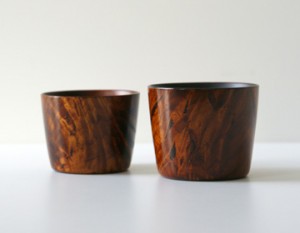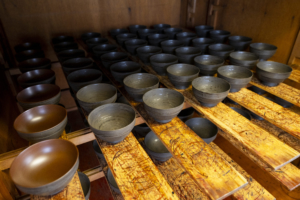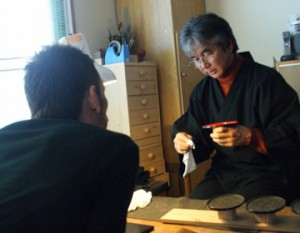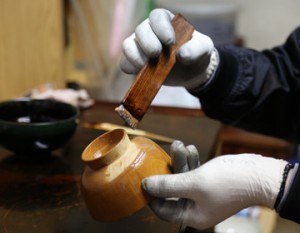The difference between “Hidehira Wan” and “Hidehira Nuri”
When you talk about lacquer ware from Iwate, ”Hidehira Nuri” is what comes to mind. As its name suggests, it was created during the Hidehira Fujiwara period, and is lacquer ware using plenty of local lacquer and gold, and it is one of the symbolic items from the gold culture of Hiraizumi.
We visited the studio/home of Morio Oikawa who has a long career as a lacquer artist. In his home, there were many lacquer ware. Amongst that there were many ”Hidehira Nuri. Oikawa brought out a set which consists of 3 pieces to serve a bowl of soup and a vegetable dish. This was ”Hidehira Wan” that Oikawa reproduced.
The name sounds similar but actually this ”Hidehira Wan” is the origin of the current ”Hidehira Nuri”. Lacquer ware with an elegant shape, exquisite pattern, and a thick body. It makes your heart tremble just looking at it.
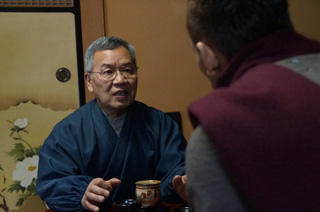
Taking over the family business of making lacquer ware
Oikawa was born in Masuzawa area in Iwate Prefecture. It is an area famous for carpentry from the old days, and during the Meiji Era the ”Masuzaka Nuri” lacquerware was established as an industry. In fact this area was considered to have been making ”Hidehira Wan” for many years, and there was research about ”Hidehira Wan” by a famous folk crafts movement leader Muneyoshi Yanagi. At that time, ”Masuzaka Nuri” was basically just one color since it was made for daily use. On the other hand, there is a history of restoring ”Hidehira Nuri” which incorporated gold and patterns, which was the characteristic of ”Hidehira Wan”.
Oikawa told us, ”Making Lacquer ware by hand was one of the joys in the countryside.” ”People in this region love to make things. And everyone was involved in making ”Masuzawa Nuri”. ”Masuzawa Nuri” uses plenty of lacquer and it is layered several times which makes it very sturdy. They were not sold very widely, and only sold directly to those using it.”
The elegant patterned ”Hidehira Nuri” which is now a standard, has been mass produced since the Taisho Era. Masuzawa region is now under a dam and Oikawa is the last lacquer artist in Masuzawa.
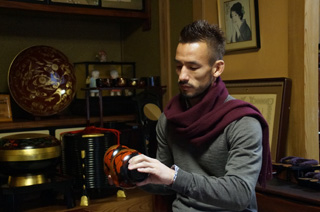
Lacquerware is not a luxury item and should be used daily
One of our staff said, ”lacquer ware seems like a luxury item” and Oikawa replied ”That is a problem, when people think that way.” Currently Oikawa is making ”Masuzawa Nuri” rather than ”Hidehira Nuri”. Basically going back to making more practical lacquer ware.
”Lacquer ware is not necessarily a luxury item. It is only receiving the wealth from nature.” Oikawa told us that lacquerware is a daily tool so it is important that they are easy to use. ”One of the problems is that a lot of people are making things thinking that they are artists. Artists and artisans are completely different. An artisan has to make good products and also make a large quantity. That is the basic idea.” He wants to send a warning to his own field of lacquerware.
To adopt lacquerware as a day to day product. Lacquer can be repaired again and again, so sometimes a lacquerware returns to be repaired after 10 – 20 years of use. This is the proof of the lacquerware being continuously used.
”If you continue that kind of work, we can survive. So we want to keep selling to the people whom we know by their faces. It is such a pleasure to connect that way.” Oikawa shared his feelings as an artisan.
